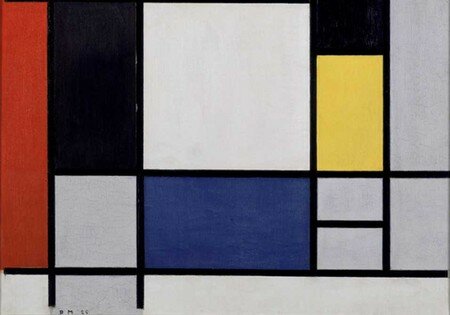Piet Mondrian au Andy Warhol Museum, Pittsburgh
Piet Mondrian, Composition with Yellow, Red, Black, Blue and Grey, 1920. Oil on Canvas. Collection of Stedelijk Museum, Amsterdam (c) 2008 Mondrian/Holtzman Trust c/o HCR International Virginia
PITTSBURGH.- A leader in abstract painting of the twentieth century, Dutch artist Piet Mondrian (1872 – 1944), was best known for his Neo-Plasticism (a Dutch movement founded and name by Mondrian) abstractions of rigid forms consisting of rectangular shapes of red, yellow, blue, or black, separated by thick, black, rectilinear lines. Mondrian explained Neo-Plasticism as absolute harmony of straight lines and pure colors underlying the visible world. This exhibition of 24 paintings, many of which have never been on view in the US, includes a selection spanning 1907 through 1937. The pictures range from early abstract landscapes such as De Rode Wolk (The Red Cloud), painted in 1907 to Mondrian’s Composition with Blue, Red and Yellow completed in 1937.
Mondrian was an important contributor to the De Stijl art movement and group, which was founded by Theo van Doesburg. He evolved a non-representational form which he termed Neo-Plasticism. This consisted of a grid of vertical and horizontal black lines and the use of the three primary colours.
Piet Mondrian, Mill, 1917. Oil on Canvas. Collection of Stedelijk Museum, Amsterdam. (c) 2008 Mondrian/Holtzman Trust c/o. HCR International Virginia

/https%3A%2F%2Fprofilepics.canalblog.com%2Fprofilepics%2F1%2F0%2F100183.jpg)
/https%3A%2F%2Fstorage.canalblog.com%2F03%2F02%2F119589%2F96711876_o.jpg)
/https%3A%2F%2Fstorage.canalblog.com%2F11%2F31%2F119589%2F94773502_o.jpg)
/https%3A%2F%2Fstorage.canalblog.com%2F20%2F83%2F119589%2F94772815_o.jpg)
/https%3A%2F%2Fstorage.canalblog.com%2F26%2F72%2F119589%2F75604929_o.jpg)
/https%3A%2F%2Fstorage.canalblog.com%2F59%2F60%2F119589%2F26458628_o.jpg)




/image%2F1371349%2F20240504%2Fob_93e6fc_440746014-1663431631093516-33520012940.jpg)
/image%2F1371349%2F20240504%2Fob_ad891b_441216662-1663349251101754-34964046851.jpg)
/image%2F1371349%2F20240504%2Fob_aed9af_441052920-1663343744435638-38708661590.jpg)
/image%2F1371349%2F20240504%2Fob_d96259_441052920-1663343744435638-38708661590.jpg)